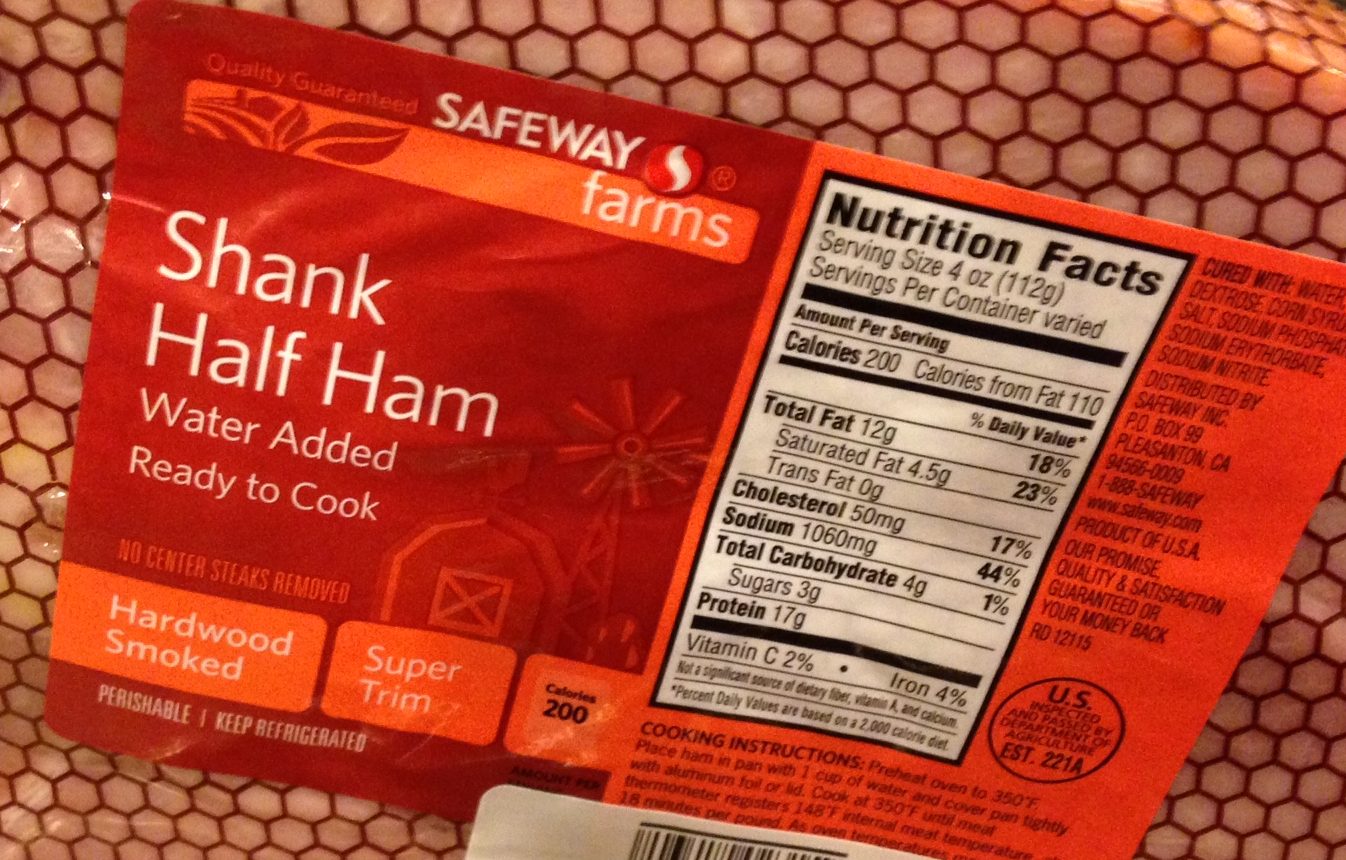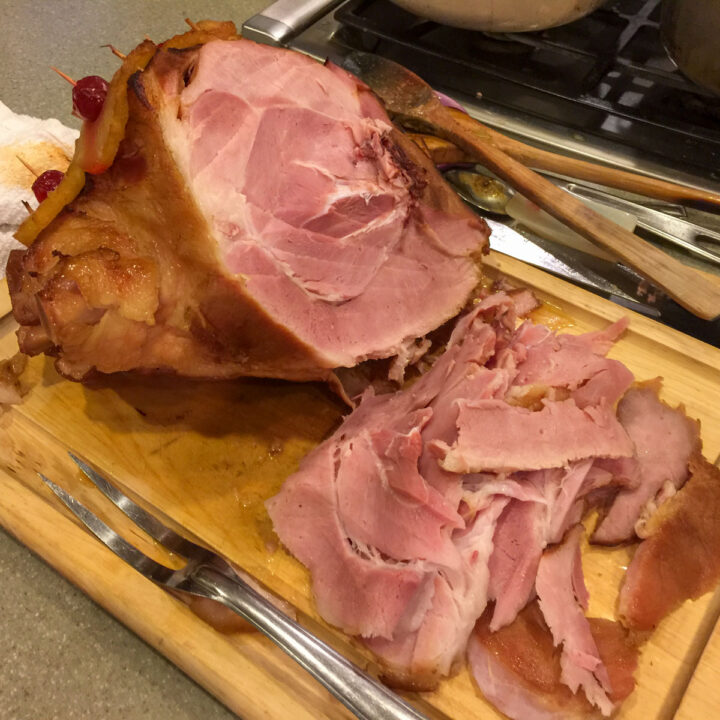Anytime is a great time to eat ham. Fried ham with eggs is a premier breakfast, and sliced ham and cheese make a perfect po-boy. Pile some sliced ham with American or Swiss cheese onto some crispy New Orleans French bread. Don't forget to ask for it "dressed", that's New Orleans vernacular for "lettuce, tomatoes, pickles and mayonnaise". Although ham is commonplace in our culinary landscape, baking or smoking a ham is the thing that makes a Sunday or an Easter Dinner special. There is something ceremonial about cooking a ham, which makes it perfect for special occasions. But if you are not used to buying a large ham, the labels can be somewhat confusing. Let's take a closer look at the ham and how they are labeled.
Jump to:
This post is not sponsored, but you will find affiliate links on this page. As an Amazon Associate, I earn from qualifying purchases. The price you pay as a consumer does not change, but I may make a small commission based on your purchase.
What Is a Ham?
Ham, simply stated, is the cut of meat from a hog's hind leg. The term does not refer to the manner in which the pork is cooked, but rather, it refers to where the specific cut is on the pig.


A whole ham can weigh between 15 and 20 pounds. A whole ham is usually separated and sold in two sections: the butt end and the shank end.
- The butt end is the top section of the ham. This makes sense...my butt is higher than my leg. The butt end is more of a rump and will be fattier.
- The shank end is the lower portion of the leg and is pointy and shaped a little like a funnel. It is comprised of more of the leg and is the leaner of the two sections.
- A Ham Shank retains its portion of the femur, plus a shank bone.
- The "shank portion" has the center slices removed to be sold separately as "ham steaks"
- A shank “half ham” does not have slices removed.
- Hams labeled “bone-in” still have the leg and shank bone and are sold whole or in shank or butt portions.
- “Semi-boneless” are hams with the shank bone removed but the leg bone still in place. These are usually sold whole.
Although it sounds like it belongs here, a picnic ham really comes from the lower portion of the shoulder, which is the front legs of the pig. So, it's not really ham at all. You need a pig skeleton to keep up with all of this.
Are all hams sold pre-cooked?
Ham can be bought fresh or cured. Fresh means it has not been processed and will be labeled Fresh Ham, while cured means that it has been processed by either a dry cure or a wet cure. Curing helps prohibit the growth of deadly microorganisms which can be present in pork and other meats. While there are variations of these methods, in dry curing, fresh ham is rubbed with a dry-cure mixture of salt and other ingredients which pulls out moisture and produces a higher intensity of flavor. While this generally produces a salty product, the USDA has made adjustments allowing curing ingredients that minimize the saltiness. Dry-cured ham includes country hams or prosciutto and typically loses about 20% of their weight in the process. More common are wet cured hams, which are cured in a brine solution of water, salt, sugar, nitrites and other ingredients and seasonings. Water is added to the ham, increasing its weight and diluting its flavor. Water can dilute the flavor somewhat as the more water that is added, the less flavor the ham will have.
I just want a ham! Why are the labels on hams so complicated?
Labeling on hams, like most food products, is regulated by the United States Department of Agriculture (USDA) to protect the consumer and assure that food safety standards are met. The fact that it's confusing is just lagniappe to them. Using USDA standardized definitions, the label tells us what we are buying and how we need to cook it so we don’t end up ingesting food-borne pathogens. I hate when that happens.
What's that Label Mean?
Basically, we are concerned with wet cured hams here. After curing, hams are usually smoked and sometimes cooked. USDA requires all of this to be reflected on the label, resulting in hams that are labeled cooked, fully cooked or ready to eat. These can be eaten right out of the package but are often preferred reheated or further smoked to an internal temperature of 140 degrees Fahrenheit. If the ham is not fully cooked after smoking, it will be instructional labeled "ready to cook" or "cook thoroughly" and must provide cooking instructions. USDA guidelines suggest cooking these hams at 325 degrees until they reach an internal temperature of 145 degrees as long as they were processed in a USDA inspected plant. If a ready-to-eat ham was not processed in USDA inspected plant, the guideline calls for an internal temperature of 165 degrees to assure that the food-borne pathogens are eliminated.

Since the wet curing process results in the addition of water in a bath and/or by injection, the USDA requires that the amount of water added to the ham be noted on the labels. There are four categories listed in the USDA definitions based on the presence of added water and the percentage of protein on a fat-free basis.
- Ham: This is a cured leg of pork that contains no less than 20 ½ percent of protein. While added water is permitted in the curing process, it must be listed in order of its proportion in the ingredients.
- Ham with Natural Juices: This is a cured ham to which the natural juices of the pork have been added back. It will contain no less than 18 ½ percent protein with 7 or 8 percent added water.
- Ham-Water Added: This cured ham is 17 percent protein with no more than 10 percent water added by weight, which means that the water is included in the ham's total weight.
- Ham and Water Product: This cured ham is less than 17-percent protein and can contain any amount of added water and additives.
NOTE: The "percent of protein" measurement given in the Code is referring to what percentage the meat is of the entire ham and additives. The wording in 9 CFR § 319.104 - Cured pork products basically says:
The minimum meat Protein Fat Free (PFF) percentage shall be the minimum meat protein which is indigenous to the raw unprocessed pork expressed as a percent of the non-fat portion of the finished product.
Ham Recipes!
If you get into either of these Ham recipes, it's best to be prepared to track the internal temperature and the cooking time. The best tools I have found to do this are from ThermoWorks.
Lagniappe-Some of my Thermoworks Tools
I am a participant in ThermoWork's Affiliate Program, so I will receive a small commission on any sale through my website links.

Measure twice, cut once. You have a lot of time and effort invested in cooking, so make sure to use tools that are reliable and of high quality. That's particularly important when you are tracking and measuring temperature and time. There can be a fine line between perfectly cooked and horribly under or overcooked. That's why I have relied on products from Thermoworks for years to give me accurate information I can count on. I have found their products to be high-quality and durable and their customer service to be second to none. Check out the Thermoworks website...you won't believe the range of products they have for measuring just about everything.
If you make this recipe:
- Tell us about it in the Comments section below
- LEAVE A RATING ON THE RECIPE-worthy of 5-Stars?
- Questions or Comments? that’s the place!
- SIGN UP FOR OUR EMAIL UPDATES so you don't miss anything!
- Post a picture and share it with your friends on our Social Media:
Yeah You Right!



Comments
No Comments